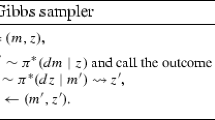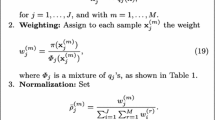Abstract
Simulated tempering (ST) is an established Markov chain Monte Carlo (MCMC) method for sampling from a multimodal density π(θ). Typically, ST involves introducing an auxiliary variable k taking values in a finite subset of [0,1] and indexing a set of tempered distributions, say π k (θ)∝ π(θ)k. In this case, small values of k encourage better mixing, but samples from π are only obtained when the joint chain for (θ,k) reaches k=1. However, the entire chain can be used to estimate expectations under π of functions of interest, provided that importance sampling (IS) weights are calculated. Unfortunately this method, which we call importance tempering (IT), can disappoint. This is partly because the most immediately obvious implementation is naïve and can lead to high variance estimators. We derive a new optimal method for combining multiple IS estimators and prove that the resulting estimator has a highly desirable property related to the notion of effective sample size. We briefly report on the success of the optimal combination in two modelling scenarios requiring reversible-jump MCMC, where the naïve approach fails.
Similar content being viewed by others
References
Atchadé, Y., Liu, J.: The Wang–Landau algorithm in general state spaces: applications and convergence analysis. Technical Report, University of Harvard (2007)
Breiman, L., Friedman, J.H., Olshen, R., Stone, C.: Classification and Regression Trees. Wadsworth, Belmont (1984)
Del Moral, P., Doucet, A., Jasra, A.: Sequential Monte Carlo samplers. J. R. Stat. Soc. Ser. B 68, 411–436 (2006)
Geyer, C.: Markov chain Monte Carlo maximum likelihood. In: Computing Science and Statistics: Proceedings of the 23rd Symposium on the Interface, pp. 156–163 (1991)
Geyer, C., Thompson, E.: Annealing Markov chain Monte Carlo with applications to ancenstral inference. J. Am. Stat. Assoc. 90, 909–920 (1995)
Gramacy, R.B., Lee, H.K.H.: Bayesian treed Gaussian process models with an application to computer modeling. J. Am. Stat. Assoc. 103(143), 1119–1130 (2008)
Green, P.: Reversible jump Markov chain Monte Carlo computation and Bayesian model determination. Biometrika 82, 711–732 (1995)
Hukushima, K., Nemoto, K.: Exchange Monte Carlo method and application to spin glass simulations. J. Phys. Soc. Jpn. 65(4), 1604–1608 (1996)
Iba, Y.: Extended ensemble Monte Carlo. Int. J. Mod. Phys. 12(5), 623–656 (2001)
Jasra, A., Stephens, D., Holmes, C.: On population-based simulation for static inference. Stat. Comput. 17(3), 263–279 (2007a)
Jasra, A., Stephens, D., Holmes, C.: Population-based reversible jump Markov chain Monte Carlo. Biometrika 94(4), 787–807 (2007b)
Jennison, C.: Discussion on the meeting on the Gibbs sampler and other Markov chain Monte Carlo methods. J. R. Stat. Soc. Ser. B 55, 54–56 (1993)
Kass, R.E., Carlin, B.P., Gelman, A., Neal, R.M.: Markov chain Monte Carlo in practice: a roundtable discussion. Am. Stat. 52(2), 93–100 (1998)
King, R., Brooks, S.: Model selection for integrated recovery/recapture data. Biometrics 58, 841–851 (2002)
Kirkpatrick, S., Gelatt, C., Vecci, M.: Optimization by simulated annealing. Science 220, 671–680 (1983)
Kushner, H., Lin, G.: Stochastic Approximation Algorithms and Applications. Springer, New York (1997)
Liu, J.S.: Monte Carlo Strategies in Scientific Computing. Springer, New York (2001)
Madras, N., Picconi, M.: Importance sampling for families of distributions. Ann. Appl. Probab. 9, 1202–1225 (1999)
Marinari, E., Parisi, G.: Simulated tempering: a new Monte Carlo scheme. Europhys. Lett. 19, 451–458 (1992)
Neal, R.M.: Sampling from multimodal distributions using tempered transition. Stat. Comput. 6, 353–366 (1996)
Neal, R.M.: Annealed importance sampling. Stat. Comput. 11, 125–129 (2001)
Neal, R.M.: Estimating ratios of normalizing constants using Linked Importance Sampling. Technical Report 0511, Department of Statistics, University of Toronto (2005), 37 pages
Owen, A., Zhou, Y.: Safe and effective importance sampling. J. Am. Stat. Assoc. 95(449), 135–143 (2000)
Veach, E., Guibas, L.J.: Optimally combining sampling techniques for Monte Carlo rendering. In: SIGGRAPH ’95 Conference Proceedings, pp. 419–428. Reading, Addison-Wesley (1995)
Wong, W., Liang, F.: (1997). Dynamic weighting in Monte Carlo and optimization. In: Proceedings of the National Academy of Sciences of USA, vol. 94(26), pp. 14220–14224
Author information
Authors and Affiliations
Corresponding author
Rights and permissions
About this article
Cite this article
Gramacy, R., Samworth, R. & King, R. Importance tempering. Stat Comput 20, 1–7 (2010). https://doi.org/10.1007/s11222-008-9108-5
Received:
Accepted:
Published:
Issue Date:
DOI: https://doi.org/10.1007/s11222-008-9108-5




